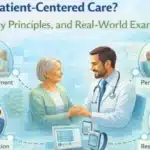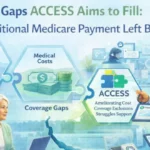Overcoming Remote Monitoring Challenges in Pain Management: RPM vs. RTM Solutions

Pain affects over 50 million adults in the U.S., yet many struggle with long-term pain management due to limited in-person care. AI-powered Remote Patient Monitoring (RPM) and Remote Therapeutic Monitoring (RTM) are transforming how pain is tracked, treated, and managed—helping healthcare providers deliver personalized remote care solutions.
To optimize pain management and improve patient outcomes, it’s essential to understand the key differences and challenges associated with RPM and RTM solutions. While RPM provides critical physiological insights for chronic pain management, RTM plays an equally vital role in tracking therapy adherence, medication use, and patient response. Together, they create a holistic pain management framework that improves outcomes.
Table of Contents
ToggleRPM (Remote Patient Monitoring) in Pain Management
RPM is particularly beneficial in managing chronic pain conditions like arthritis, fibromyalgia, diabetic neuropathy, and post-surgical recovery. By monitoring key vitals, RPM enables early detection of pain flare-ups, preventing emergency visits and improving long-term pain management.
- Used for physiological data monitoring (e.g., blood pressure, oxygen saturation, heart rate, glucose levels).
- Governed under Medicare CPT codes 99453, 99454, 99457, and 99458.
- Applies to chronic and post-acute conditions.
- Requires the collection of at least 16 days of data per month to be reimbursable.
While RPM does not measure pain levels directly, it tracks key vitals that indicate pain severity, such as blood pressure spikes, heart rate variability, oxygen levels, and glucose fluctuations. These insights help providers adjust pain management plans based on objective physiological markers.
In addition to medication tracking, RPM can support non-pharmacological pain management approaches, such as tracking sleep disturbances, physical activity, stress levels, and dietary habits. These factors significantly impact chronic pain and can be integrated into a holistic pain management plan
RTM (Remote Therapeutic Monitoring) in Pain Management
RTM enhances at-home care for people with musculoskeletal, respiratory conditions, and those undergoing Cognitive Behavioral Therapy (CBT). It increases patient engagement in their treatment plan and provides virtual monitoring in between clinic appointments.
- RTM is used to monitor patients with respiratory and musculoskeletal conditions and those undergoing CBT. The following non physiological parameters are monitored- appetite, anxiety, depression, pain, fatigue, sleep, exercise, therapy adherence as well as medication adherence.
- Governed under CPT codes 98975, 98976, 98977, 98978, 98980, and 98981.
- Typically used by orthopedists, primary care practitioners, physical therapists, occupational therapists, speech-language pathologists (non-physician providers can bill for RTM, unlike RPM).
Remote Patient Monitoring Challenges & Solutions for Pain Management
Remote patient monitoring companies, like HealthArc, are overcoming significant barriers and paving the way for hassle-free remote healthcare with its highly advanced and easy-to-use digital health platform that provides a wide range of remote care services like Remote Patient Monitoring (RPM), Chronic Care Management (CCM), Principal Care Management (PCM), Transitional Care Management (TCM), Remote Therapeutic Monitoring (RTM), and Behavioral Health Integration (BHI), along with AI scribe and transcription functionality.
Some of the biggest challenges in using RPM for pain management and strategies being followed to overcome them include:
- Patient Engagement and Adherence: Most of the time, patients struggle to utilize RPM devices to report their vitals or are not able to follow the prescribed monitoring protocols, thereby leading to improper patient engagement, inefficiency in data collection, and medication adherence. Some ways in which HealthArc is promoting patient engagement and adherence include:
-
- Education & Training: By providing the support, education, and training on how to use the RPM devices with a free demonstration and simple instructions, it is improving patient engagement rate.
- Automated Reminders: Along with education and training, automated reminder functionality via application notifications, SMS, or calls reminds patients that they need to take their vitals’ reading and record the data on the platform.
- Data Overload For Automated Insights: Since patients monitor and record their vitals every day for continuous monitoring by a healthcare provider, an RPM platform generates a large amount of data that can overload the database. An overloaded system can overwhelm a healthcare provider and may cause difficulty in identifying the pain levels in a chronic patient. To generate automated insights and avoid data overload, HealthArc focuses on:
-
- Customized Dashboards: With easy to navigate and customized dashboards, providers can highlight the metrics they want to monitor so that patient can easily fill them up.
- Automated Data Analysis: Our cloud based advanced digital care platform allows analyzing and prioritizing data using certain filters so that providers can quickly identify any fluctuations and provide actionable insights, thereby reducing workload.
- Technical Barriers: Older adults having little knowledge about modern day technology and limited access to remote care often face difficulty in using cellular medical devices. Other than this, patients located at remote locations may face connectivity issues or hardware malfunctions that can limit their access to pain management programs. HealthArc overcomes this difficulty by providing:
-
- Easy-to-use Platform: Our platform is designed keeping ease of use in mind and has a clear interface to make sure even older adults can easily access and record their vitals. Likely, healthcare providers can also quickly access their patient’s health data without needing much technical expertise.
- Technical Support: To ensure patients can understand how the RPM system works, the platform provides live support, troubleshooting guides, and video call assistance to help patients with device setup and usage.
- Integration with Existing Healthcare Systems: Healthcare providers often face difficulty in integrating an RPM platform with their existing Electronic Health Records (EHR) system. But, HealthArc checks all the boxes here by integrating with a number of EHRs, without any loss of patient or provider data. It also allows providers to view and analyze patient data from a unified dashboard. It helps with:
-
- Interoperability: An RPM platform that offers interoperability features allows seamless integration with an EHR, alongside other patient health records.
- Collaboration with Vendors: By collaborating with 20+ EHRs and compatibility with 40+ medical devices, HealthArc ensures seamless connection.
- Privacy and Security Concerns: Since most remote monitoring systems operate over the cloud, the risk of data privacy and security often lets down the providers planning to implement an RPM program. HealthArc’s remote monitoring platform ensures data security and privacy with HIPAA and SOC 2 compliance, thereby preventing the risk of data breaches.
-
- Compliance with Regulations: A secure RPM platform is fully compliant with HIPAA (Health Insurance Portability and Accountability Act) privacy regulations.
- Encryption and Secure Storage: With the use of strong encryption protocols, our platform protects patient data both during the transmission and storage.
- Cost and Access to RPM Tools: Another challenge that usually concerns healthcare providers is the cost of devices, software, and internet access that is needed to provide remote health access to patients. Especially for healthcare providers having the majority of patients living in remote locations with limited internet connectivity, access to RPM services may be difficult. HealthArc’s RPM platform provides cost and accessibility solutions by ensuring:
-
- Affordability: Our health system is quite affordable compared to other unified health platforms and has partnerships with insurers to subsidize costs for patients and generate high reimbursements for providers.
- Cellular Connectivity: Compared to WiFi devices, HealthArc’s cellular devices promise better connectivity and help bridge the digital divide. Some of its other benefits include:
- No Wi-Fi required
- Network independent
- 4G enabled, with 2G fall back
- Reading can be stored in an offline mode
- Can be used in 150+ countries
While RPM plays a significant role in improving pain management, only a few remote health software address the above described challenges by focusing on simplicity, accessibility, and robust data management.
Remote Therapeutic Monitoring Challenges & Solutions for Pain Management
Remote Therapeutic Monitoring (RTM) has rather emerged to become an integral component in chronic pain management and is useful in conditions like musculoskeletal disorders, persistent neurological conditions, and all chronic pain syndromes. It helps track the efficiency in physical therapy, medication adherence, and overall progress in the patient’s condition.
Some of the biggest challenges in using RPM for pain management and strategies being followed to overcome them include:
- Patient Engagement and Adherence: Most RTM systems expect the patients to participate in certain therapeutic activities, such as physical therapy exercises or medication regimens. This is a considerable challenge because many pain management regimens will require adherence from patients for effective results. To address this challenge, RTM needs to focus on:
-
- Behavioral Interventions: Providing motivational support, reminders, and feedback through the RTM system can keep patients engaged, track progress and also improve patient adherence.
- Education and Support: Patients can be educated about the importance of maintaining consistency in therapy with regular virtual consultations from healthcare providers.
- Limited Scope of Monitoring: RTM focuses primarily on things like adherence to physical therapy, intake of medication, or use of a therapeutic device. This narrow focus means that it may miss tracking other essential components of pain management, such as psychological issues (like depression or anxiety) or environmental ones that may act on the pain levels. To address this challenge, RTM need to follow:
-
- Holistic Monitoring Approach: This monitoring approach along with health assessment may enhance communication on mental health, emotional well-being, or environmental factors (e.g., sleep quality and stress level) to give a much more rounded view of a patient’s pain management journey.
- Integration into RPM: By linking the RTM process into a broader system of Remote Patient Monitoring, a fuller view can be available to figure out both the efficiency of therapeutic interventions and other health vitals.
- Barriers to Technology and Accessibility: Some providers may struggle with using the RTM platform, acting as a barrier to accessing proper treatment. Patients can find it hard to understand how to operate the platform or lack the required technological infrastructure (internet access, smartphones, computers) which acts as a barrier to receiving proper treatment. HealthArc’s RTM platform address this issue with:
-
- User-Friendly Platform: User-friendliness for both RTM devices and apps is key to actively engaging patients with their needs. Simplifying the interface and involving the patients with education on using the technology can eliminate frustration.
- Support Services: The provision of support services for assisting patients in troubleshooting their issues with round the clock customer representative ready to help them out, until they become fluent in using these digital platforms.
- Data Overload and Interpretation: RTM generates a lot of patient data related to therapy adherence, patient progress, and other metrics. Information overload can burn out the healthcare providers or slow them down in making decisions. To avoid this data overload, RTM software should focus on:
-
- AI and Data Analytics: Automating patient data processing with Artificial Intelligence (AI) and data analytics helps prioritize information that clinicians need to focus on within the most critical health trends. Patients’ behavioral patterns can also be identified for treatment adjustment.
- Automated Alerts: By allowing automated alerts or notifications for missed therapy sessions, non-medication adherence, lack of progress, health practitioners can respond quickly without having to review huge amounts of data.
- No Real-time Feedback on Therapeutic Response: It is a challenging task to evaluate the effectiveness of therapy when it is done remotely. Though the RTM system track adherence and patient progress, it will not represent real-time therapeutic feedback on the efficiency of pain management or functional improvement. To avoid any pain management delays due to feedback, RTM should ensure:
-
- Regular Check-ins: Routine virtual check-ins with healthcare providers could benefit the patient in continuously monitoring therapeutic progress and adjusting the therapy plan as needed. Real-time feedback from both patients and providers may facilitate therapy outcomes.
- Patient-Reported Outcome Measures (PROMs): PROMs in RTM systems could assist in analyzing patient pain reports, emotional behavior, and general wellness. Such reports may prove helpful in modifying treatment plans.
- Costs and Reimbursement Issues: Although RTM promises better pain management, the high costs of implementation are considerable barriers to its adoption. Not only this, healthcare providers may face challenges in receiving reimbursement for their time and efforts in managing patients remotely. To address these challenges, RTM focuses on:
-
- Advocacy for Policy Change: As RTM systems gain more recognition and demonstrate their value in improving patient outcomes, there is potential for increased reimbursement and policy change. Engaging in some advocacy for ensuring reimbursement for RTM services would make access to this technology more easily available to healthcare providers.
- Cost-Effective Solution: Healthcare providers could engage their technology partners in lowering the upfront RTM investments. Focus on unified digital platforms that offer RTM functionalities alongside the current telehealth and electronic health record (EHR) systems.
Key Takeaways
- RPM vs RTM: RPM tracks clinical data; RTM captures patient‑reported outcomes.
- Challenges: Solve device, engagement, and data accuracy issues.
- Better Outcomes: Use both for personalized, timely pain management.
- Stay Compliant: Ensure HIPAA and CMS adherence.
Frequently Asked Questions (FAQs)
Issues such as monitoring technological reliance, adherence, the accuracy and relevance of the data collected, device interoperability, and the ethical privacy aspects of remote monitoring all present challenges.
RPM tracks real-time data as it is captured, streamlines the communication between the patient and the provider, and enables the seamless modification and adjustment of pain management strategies and schedules.
While RPM is focused on chronic condition data monitoring, RTM takes a different approach by concentrating on non-physiological data such as patient-reported outcomes, adherence to prescribed regimens, and other participant-generated data.
Both strategies could be effective since each has its advantages: RPM is beneficial for on-going clinical monitoring, and RTM is better for involvement beyond the clinical setting and self-reports.
These strategies enhance the management of pain and satisfaction by offering timely action, customized plans, and timely outreach for active interactions.
Boost Pain Management Outcomes With HealthArc’s RPM & RTM System
RPM and RTM work together to create a comprehensive pain management strategy. While RPM monitors physiological indicators that suggest worsening pain (e.g., increased heart rate, poor
sleep), RTM ensures patients adhere to their prescribed therapy and medication schedules. By integrating both, providers get a full picture of the patient’s pain experience and can intervene
proactively.
HealthArc is a dependable digital health platform that strives to improve patient care by helping providers with care coordination and better patient engagement. Our software enables patients to record their vitals via FDA-approved devices, and enhances patient outcomes, lowers healthcare costs, and boosts clinical efficiency. Some of the other features include:
- Real-time monitoring of patient vitals
- AI-based medical scribe tool
- Improved clinical decision support using data insights
- Maximized reimbursement opportunities
We help practices connect to their patients, optimize reimbursements, and minimize documentation with editable care plan templates. Providers can communicate with patients via audio and video calls, refill prescriptions, review diagnostics, and make referrals.
To find out how our digital health platform can help improve pain management, schedule a free demo or give us a call at +201 885 5571.
Most Recent Blogs
Categories
Related Blog
- December 17, 2025 | Read Time: 9 mins
The ACCESS Model and the Platform Practitioners Need to Do Well in Outcome-Based Care
The change from volume-based healthcare to outcome-based care is no longer on...
Learn More- July 12, 2025 | Read Time: 11 mins
How Remote Monitoring & AI Are Tackling Burnouts in Small Practices?
Approximately half of U.S. physicians experience symptoms of burnout, including exhaustion, cynicism,...
Learn More- June 21, 2025 | Read Time: 8 mins
Chronic Care Management Trends 2025: CMS Updates, AI Tools & RPM Integration
While healthcare delivery has become more accessible, chronic conditions continue to impact...
Learn More


